Best Anchor Pin For Your Kayak (Plus Anchor Pin Storage Tip)
- By: Joseph Simonds
- on
- Found In: Fishing Tips, Kayak Fishing
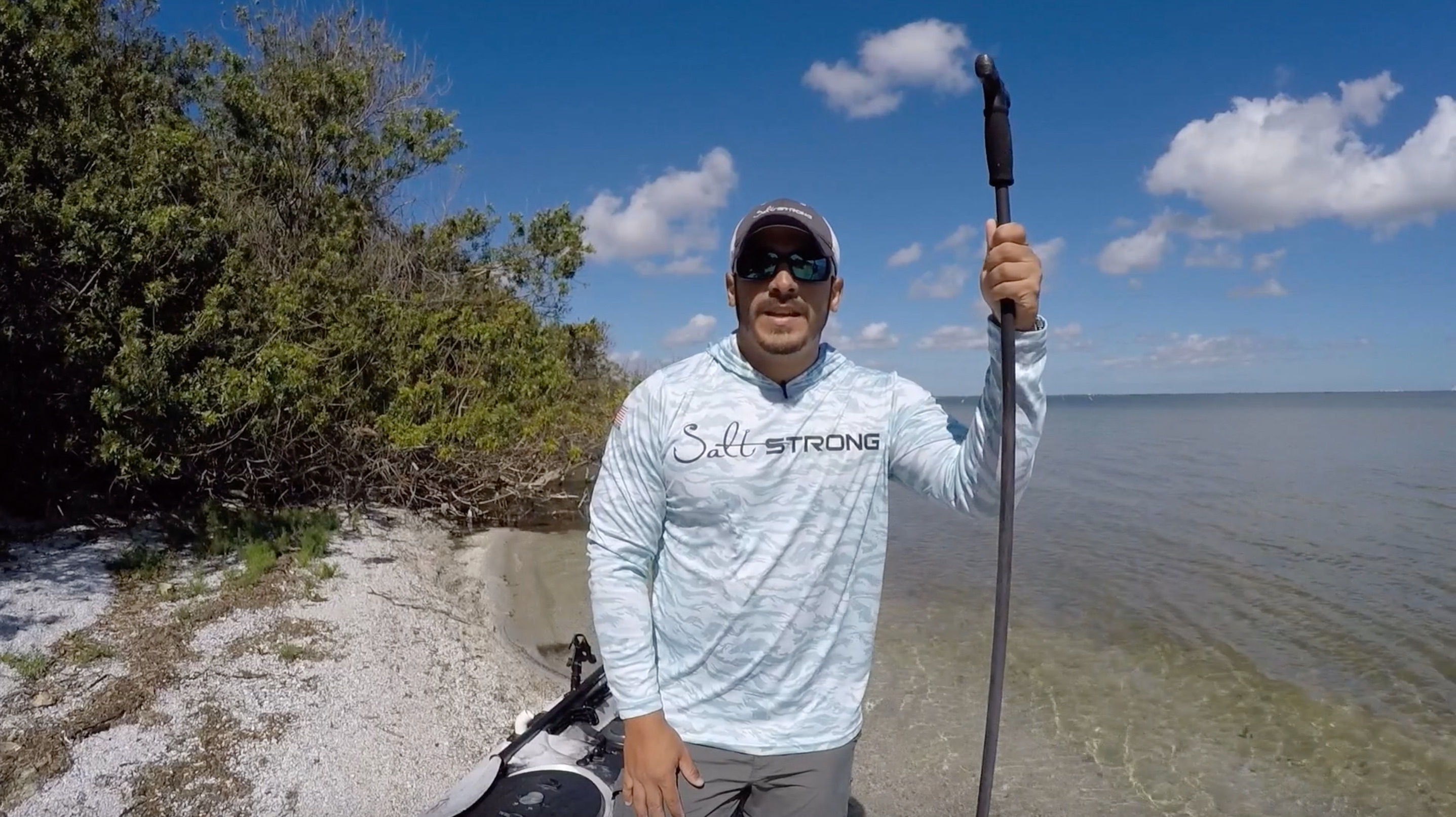
Kayak anchor pin time!
Anchor pins (also called stake-out poles) are by far the most effective tools to anchor yourself in shallow water when inshore fishing… especially when used within an anchor trolley system.
As with most fishing equipment, there are numerous types out there and they range in length, diameter, and the material they are made out of.
I want to go ahead and explain the advantages and disadvantages of these different anchor pins, and help you narrow down which one would work best for you.
Anchor Pin Ideal Length
The length of the anchor pin really depends on how deep you typically fish.
Most of the best anchor pins range on average from 4 to 8 feet long.
Note: You must also factor in an extra foot or so that the anchor pin will have to go into the bottom in order to stay put.
I typically fish in water from 6-inches to 5-feet deep, so I went with a longer anchor pin in the 7 to 8-foot range.
This will accommodate anchoring up in most areas that I fish.
In addition to serving as an anchor, these longer anchor pins can also double as a push pole to help maneuver your kayak in shallow water.
Anchor Pin Diameter
How thick the anchor pin is usually associated with the length.
These longer anchor pins will be a bit thicker than the shorter ones depending on the brand.
A ¾ inch pin is a standard thickness of most pins in the 7 to 8-foot range.
Shorter pins will be in the ½ inch range.
If anchoring in a harder bottom, these thinner anchor pins can be a little easier to get into the ground, but the ¾ inch pins are still fairly thin.
Want More Inshore Fishing Spots?
Then Click here to see if you qualify to be a Salt Strong Insider.
Anchor Pin Construction
Believe it or not, the material that an anchor pin is made out of will greatly affect its performance.
By performance, I mean the ability to anchor yourself and to stay anchored.
The best anchor pins will be made of fiberglass composite.
This makes them very strong and gives them a bit of weight which helps keep the pin in the ground.
The “Stick-It Anchor Pin” is a great example of this and is what I have always used (this is my favorite that I have tested out).
Here is a link to check them out – https://www.stickitanchorpins.com/
With these anchor pins being dense and heavier, they will sink to the bottom if dropped overboard and not secured properly.
An easy fix for this is to simply slide a piece of pool noodle to the top and secure it with zip ties.
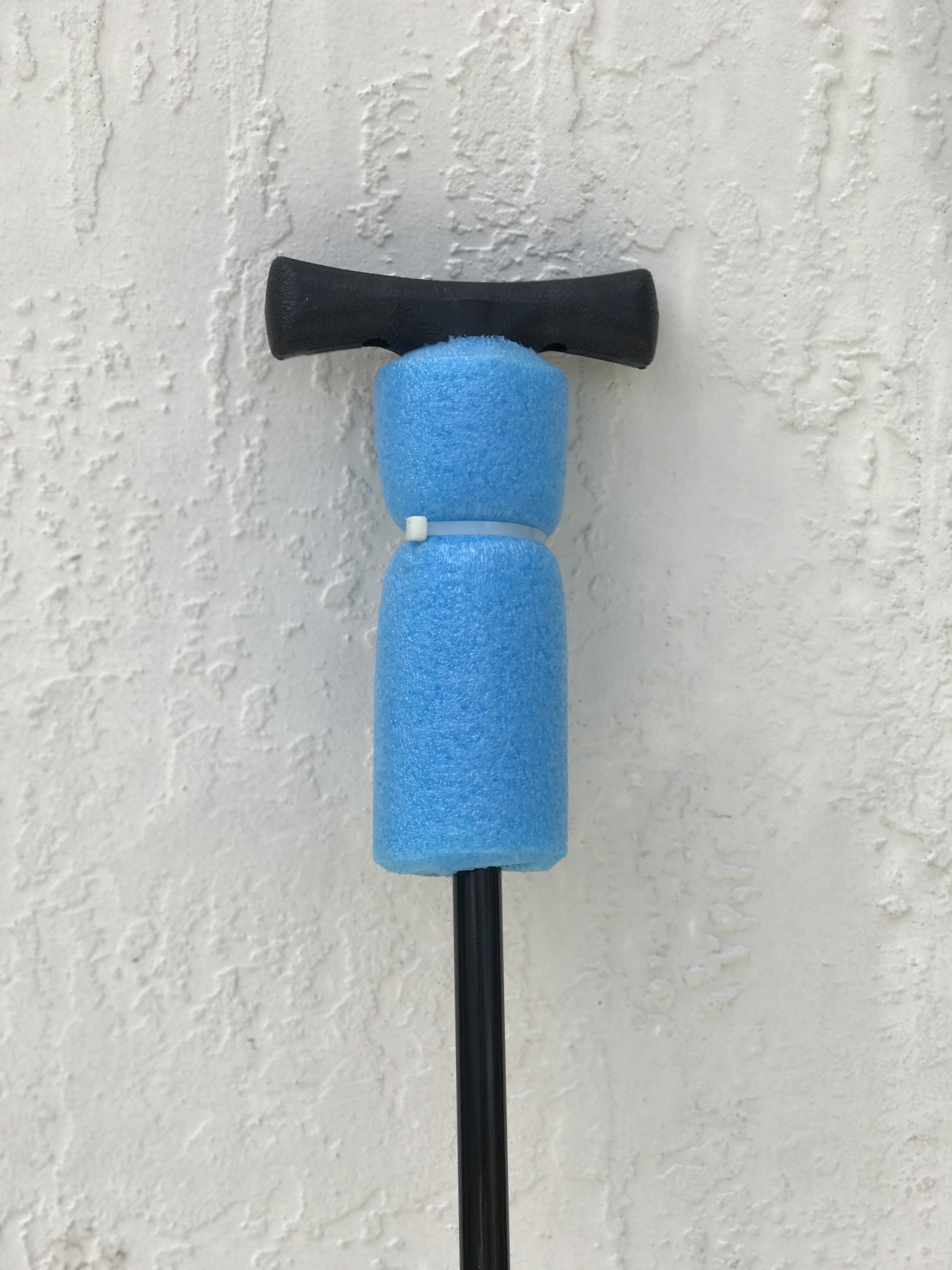
What you want to avoid are anchor pins made of lightweight material such as PVC, wood, plastic, or carbon fiber.
As these materials are nice and lightweight, (which can be convenient when bringing on a kayak) this hinders their ability to stay in the bottom as they will want to float up.
The suction on the anchor pin when stuck into the ground helps it stay put, but as your kayak tugs on the pin it will start to come loose and widen the hole that it has made in the ground, resulting in the anchor pin wanting to float up as it comes free.
Having that extra weight that a fiberglass composite pin has will help it stay put.
Now that you have this 8-foot long stick on your kayak, you may think to yourself “Where in the world am I going to store this thing?”
I’ve got you covered!
The best way that I have found to store an anchor pin is similar to how you would store your paddle when not in use – on the side of your kayak.
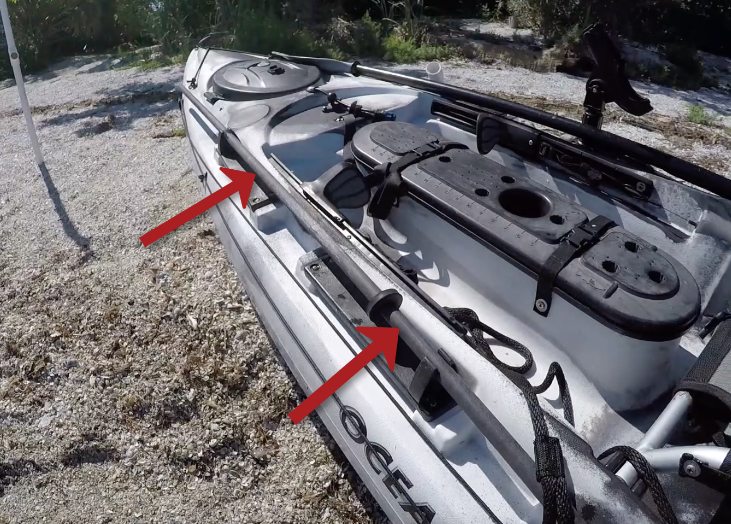
There are clips that are made to store light poles for boats that work perfectly to store a ¾ inch anchor pin.
You will just need to mount these in a location that will not affect your paddling stroke when your anchor pin is placed in them.
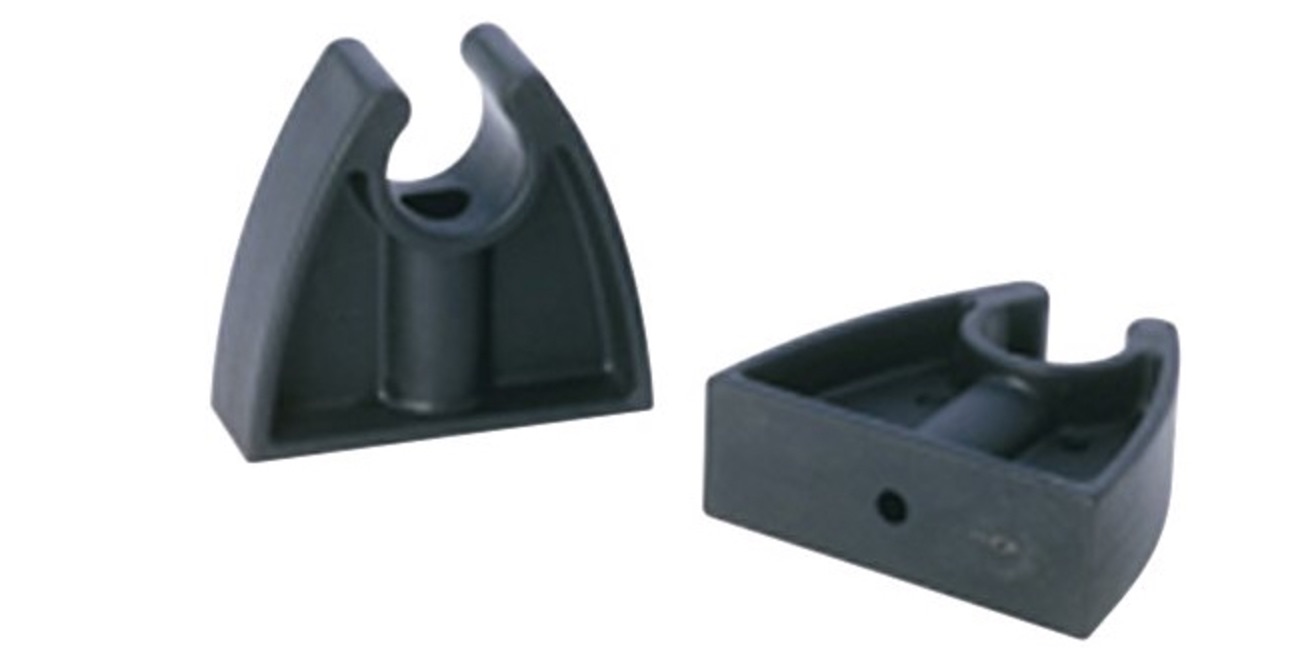
Click here to view/purchase a set of these storage clips on Amazon
If your kayak is equipped with a bungee to hold your paddle when not in use, you could also use this to store your anchor pin.
The Big Anchor Pin No-No
I see a lot of people stick their anchor pin through a scupper hole on their kayak to anchor themselves.
As this helps to quickly stop yourself, you are also putting a lot of pressure on the scupper hole as your kayak moves around.
These are one of the weakest spots on your kayak and the most vulnerable areas for leaks that are hard to detect.
Do yourself a favor and tie a rope to your anchor pin and connect the rope to your kayak.
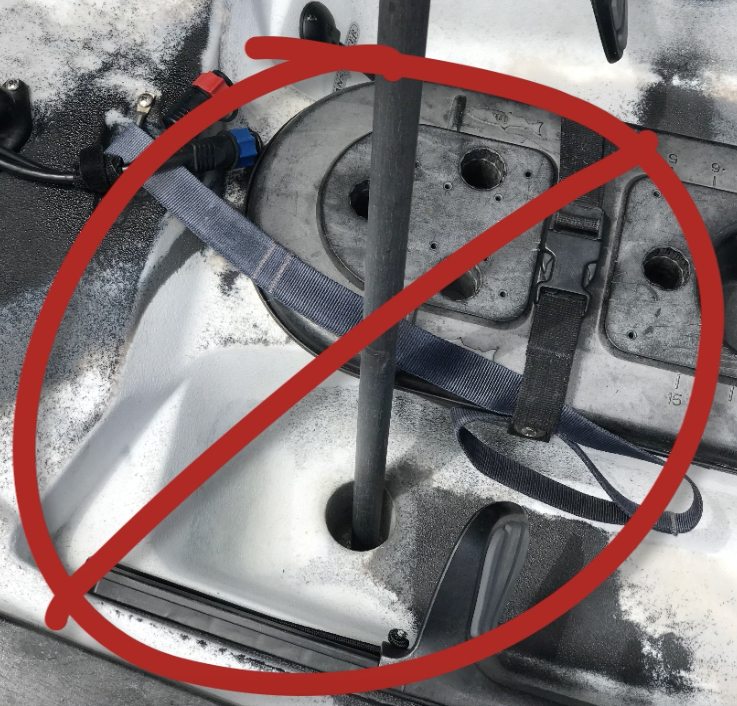
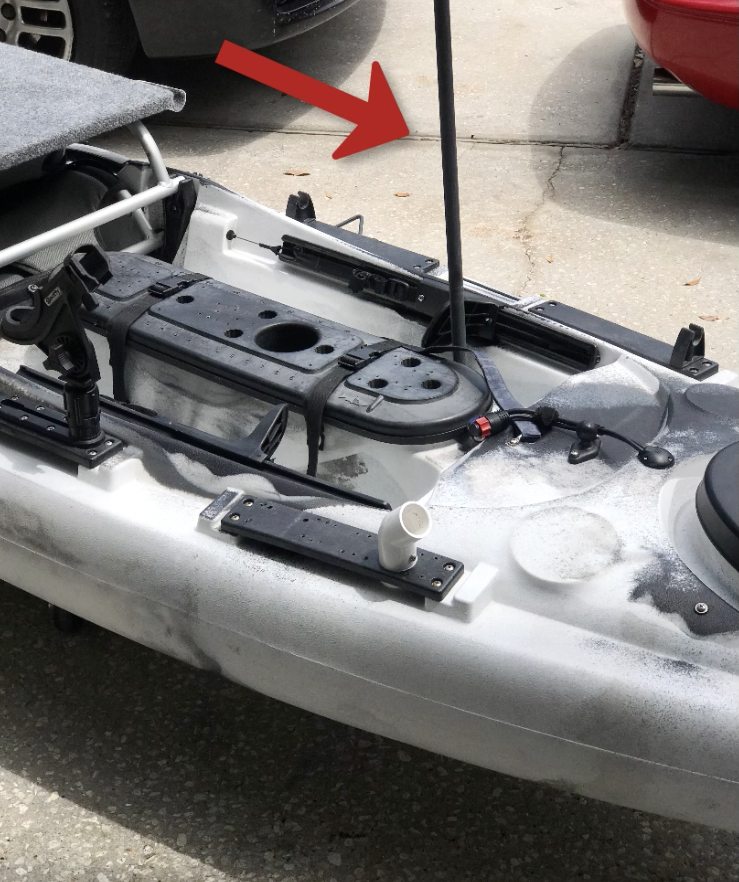
Connecting your anchor pin to an anchor trolley is an even better method which you can see demonstrated by clicking here.
In the following video, I will be giving you some very helpful tips on using an anchor pin, and also showing you how to store one on your kayak
Anchor Pin Tips [VIDEO]
Conclusion
Having an anchor pin while kayak fishing is a must.
It turns a breezy day of fishing into a killer day by keeping you in place and giving you more opportunity to stay near your honey holes.
My favorite anchor pin so far is made by Stick-It.
Finally, make sure you have your anchor pin secured on your kayak.
Nothing worse than having your pin fall in the water or bang around your kayak.
What’s your favorite anchor pin?
Let me know in the comments.
Related Post: How To Most Effectively Use A Kayak Anchor Trolley System
Want More Inshore Fishing Spots?
Then Click here to see if you qualify to be a Salt Strong Insider.
P.S. – If you think your angler friends or fishing networks would like to see this, then please Tag them or Share this with them. You Rock! Pa-POW!
Related categories:
STOP WASTING TIME ON THE WATER!
Do what the “SMART ANGLERS” are doing and join the Insider Club.
Here’s what you’ll receive today when you join:
- Weekly fishing reports and TRENDS revealing exactly where you should fish every trip
- Weekly “spot dissection” videos that walk you through all the best spots in your area
- Exclusive fishing tips from the PROS you can’t find anywhere else
- Everything you need to start catching fish more consistently (regardless if you fish out of a boat, kayak, or land).









Great article, Tony. I know it’s not exactly recent, but I am shopping for a new stick and this was helpful.
Tony, I just got an 8′ Stick It pin. It comes with two lanyards, 24″ and 84″. I see in the video, you’re using a long lanyard. I’m wondering what the 24″ one would be used for. Any ideas?
Hey Tony, do you think this anchor pin would stay in a standard vertical rod holder on my paddle board or would it be too top heavy and topple over? I don’t have anywhere to attach grommets or a holder as of now.
This may be a “dead” thread, but wondering what you used for your rubber grommet? Did u modify an existing product or MacGyver something. Its a great idea and can see where one above and below might be helpful
Hey Mike!
I use a lanyard keeper made by stick it anchor pins. It’s made for 3/4” poles:
https://stickitanchorpins.com/shop/
Thanks
can you put the anchor pole thru your scufer hole too instead of roping if off ?
Yes, but we don’t typically do that because it can cause noise if waves come by… plus we’ve heard about people wearing the scupper wall down so much over time that it causes a leak. But in calm water, it should be just fine.
Really awesome when you Google stuff about anchor pins and Tony Shows up!! Great job…. I’ve recently just started using an anchor pin and I love it. Just gotta make sure you’re not over Rocky areas!
Great tips!
I dont anchor very much in my yak other then to either eat my lunch or to get out and wade fish probably because i really dont need to considering i use and own a hobbie outback with a peddle drive system but i did make a very effective stick pole out of pvc now yes you are right if you just use the pole it will float but i solved that by drilling holes in it that not only stops the floating problem but it also cleans the hollow tube from mud and or sand that would otherwise plug the tube and i cut the end like a hyperdermic needle so it easily sticks in the sand or mud i attach a rope that is tied to my kayak handle and if i want to control which direction the kayak points at I just point it in the direction then tie the pole off next to my yak instead of letting slack in it if wading works great and definitely costs less then about 90 bucks for a stick it pin handle but I do own the stick it pin for my boat though and use the mount that attaches to the motor mount very effective for a boat but to me to expensive for my yak and the pole on my yak is attached with the bungee cord mounted on the side it has one on each side one for the paddle and the other for whatever anyways thanks for the info and or tip
When they start to wear out and Fiberglas fiber get stuck in you fingers do you just repaint to repair or is there another option
Thanks in advance
Hey Joe,
I haven’t had any issues with the material wearing out or splintering. This pin shown in the video is a “Stick-It Anchor Pin” and is a composite material.
Hands down my vote is for the YakAttack ParknPole stored on a RotoGrip Paddle Keeper (really good at keeping the noise low).
How long is the ParknPole? I have considered looking for a longer stick so I can use it as a push pole as well. Right now I have a 7ft stick it pin and it just isn’t long enough to pole with, so I have a 10ft wooden dowel I use as a push pole.
Definitely you should check out the ParknPole Link then. It is a 2-piece 8′ pole and it can have another 46” added to it if you picked up the extension piece as well. The other ParknPoles are 6′ and 8′ 1-piece poles.
*There are a few 3′ factory seconds poles left for those staking out that shallow
Awesome post Tony!
I made my own pin out of sch. 40 PVC about 5.5 feet long. I did this strictly for economic, both monetary and ease of access, reasons. With my end cut at a slant and open, I haven’t, yet, had any problems with the PVC wanting to float up. The open pipe seems to create a decent amount of suction the keeps the kayak in place. I could see it becoming a problem if I were to try and anchor on some harder bottoms, because of the OD of 3/4″ PVC being slightly larger than 3/4″.
I will definitely be looking into those pin holders for both my homemade pins and paddle. This will give me a lot of room when paddling through those low crossings of pairs and mangroves. Thanks again Tony for the great advise.
Thanks for the feedback Nick!